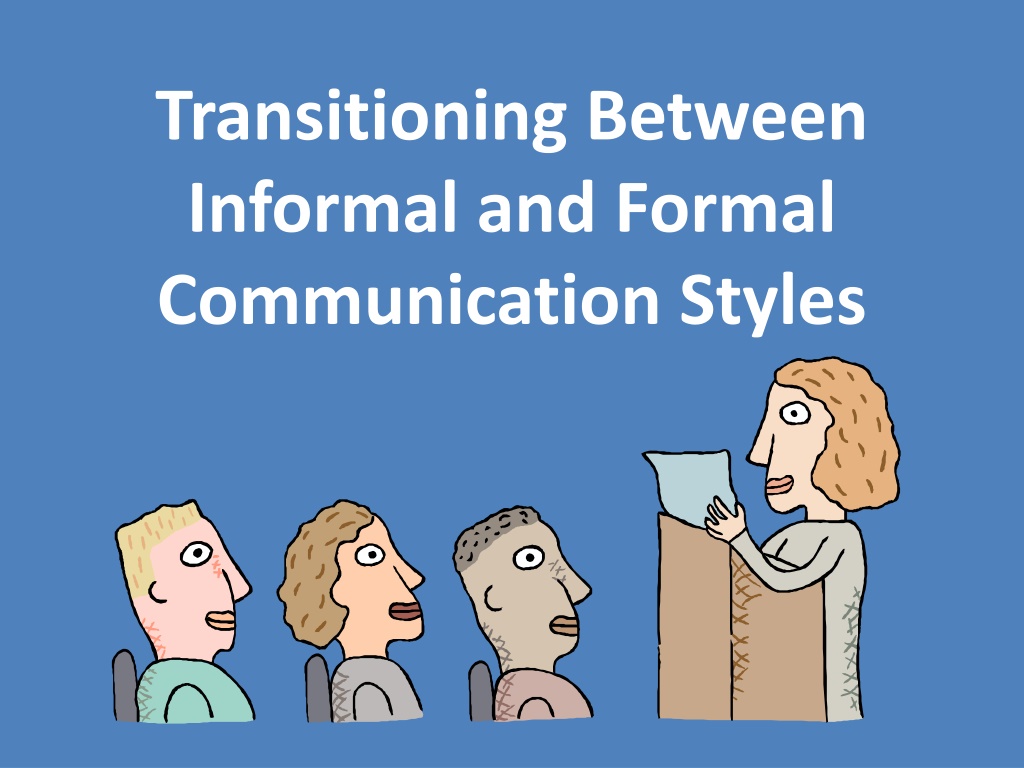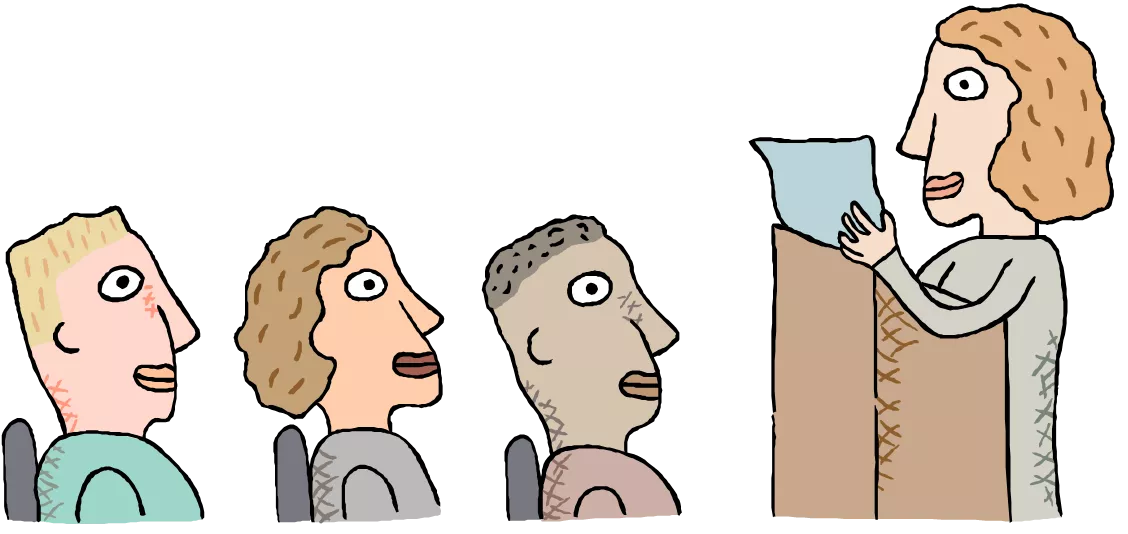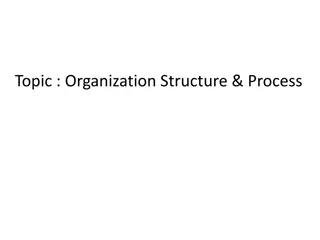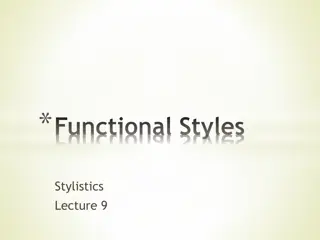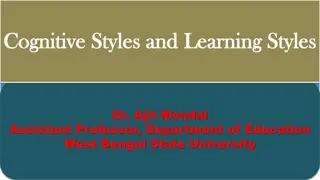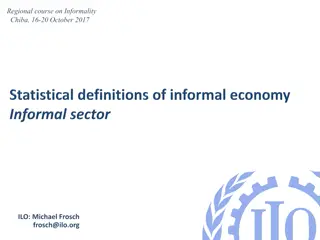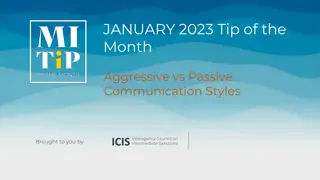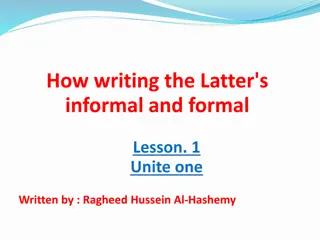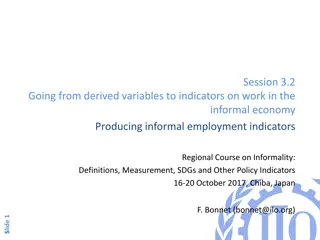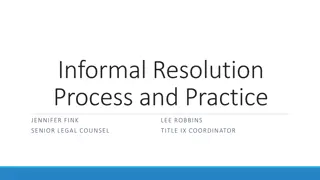Mastering Communication Styles: Informal vs. Formal
Explore the nuances of transitioning between informal and formal communication styles, understand the components of different forms of communication, and learn when to apply each style in appropriate situations. Delve into the characteristics and examples of informal and formal communication, and discover how to navigate between these styles effectively.
Download Presentation

Please find below an Image/Link to download the presentation.
The content on the website is provided AS IS for your information and personal use only. It may not be sold, licensed, or shared on other websites without obtaining consent from the author.If you encounter any issues during the download, it is possible that the publisher has removed the file from their server.
You are allowed to download the files provided on this website for personal or commercial use, subject to the condition that they are used lawfully. All files are the property of their respective owners.
The content on the website is provided AS IS for your information and personal use only. It may not be sold, licensed, or shared on other websites without obtaining consent from the author.
E N D
Presentation Transcript
Transitioning Between Informal and Formal Communication Styles
Forms of Communication and their Components Verbal Written Verbal Oral Language Vocabulary Content Structure Tone Grammar, spelling, punctuation, capitalization, etc. Nonverbal Body language Gestures Eye contact Facial expression Voice (tone, volume, pitch, etc.) Personal space Appearance Language Vocabulary Content Structure Tone Sentence structure Fluency
Communication Styles Informal and Formal Can apply to any mode of communication written, oral, nonverbal/body language Both styles are necessary Appropriate style depends on the situation or setting and the people involved
Communication Styles Informal Communication Is less rigidly structured Formal Communication Is more rigidly structured Has a more relaxed tone Has a more formal tone Uses more casual language Uses more standard language Places less emphasis on correct grammar and spelling Places higher importance on correct grammar and spelling Is used mainly with peers and other people you know well Is used mainly with non-peers & people you don t know well Is more likely to be needed in personal situations Is more likely to be needed in business, career, or educational situations
Examples of Appropriate Situations for Using Each Communication Style Mode of Communication Informal Formal Text message to a friend Email to a professor Birthday card for a relative Resume & cover letter Verbal Written Grocery list English paper Tweet or Facebook status Online discussion board post Skyping with a sibling Tutoring Family dinner Job interview Verbal Oral/Spoken Socializing at a club meeting In-class presentation Getting to know your roommate Scheduling a doctor s appointment Riding the bus Sitting in class Dinner out with a friend Interacting with customers at work Nonverbal Watching a movie at home Turning in a job application Hugging your mother to say hello Shaking hands to greet your boss
Samples of Informal and Formal Communication Styles Scenario Informal Communication Formal Communication You want to confirm that you have an appointment with a professor by speaking with him after class. (Verbal-Oral) Hey, we still meeting today, Dr. J? Hello Dr. Jones. I just want to confirm that we re meeting today at 4:00. Does that still work for you? You were supposed to meet a friend at the gym, but she s 45 minutes late. You send her a text message. (Verbal- Written) hey, where r u? weren t we working out at 3? u ok?? Jessica, please update me on your whereabouts. I m concerned that you haven t arrived for our 3:00 pm workout. Please contact me ASAP. Best wishes, Taylor Your professor has flagged your paper as potentially being partly plagiarized. (You think it s most likely an error because you didn t cheat intentionally.) You are meeting with her to find out why the paper was flagged and hopefully to clear it up. (Nonverbal) You show up for the meeting wearing pajama pants and a dirty sweatshirt. When you enter her office, you throw yourself into a chair and heave a huge sigh. During the conversation, you look at the floor and glare or scowl. When she explains why the paper was flagged, you shout that s ridiculous! and throw your arms in the air. You show up dressed in what you would normally wear to class or work. During the conversation, you stand up straight, make eye contact with the professor, and use active listening skills such as nodding when she explains something. You keep an even tone and don t raise your voice. You stay out of her personal space except to lean in and point at a passage in the paper once.
Why does communication matter? Expectations related to communication change as you enter college and become an adult When you use effective and appropriate communication, other people are more likely to Have a positive impression of you Take you seriously; relate to you as a peer and adult Offer you assistance and give you the benefit of the doubt when needed
Making the Transition Informal communication is appropriate In most situations high school students encounter In many situations college students encounter However, college students encounter more situations where formal communication is necessary and appropriate In college, you will need to transition back and forth between formal and informal communication styles much more frequently
Types of College Communication In college, you will likely need to Send emails Attend tutoring, study groups, or review sessions Leave voicemails Participate in class discussions Meet with a variety of educational professionals (e.g., advisor, professor, financial aid counselor, disability support staff, residence hall leader, etc.) Work on group projects Apply and interview for a job or internship Ask questions (in & out of class) Interact with people outside of the university setting for independent living tasks (e.g., schedule doctor s appointment, get car s oil changed, etc.) Write papers & assignments Give presentations
Communication Tips for the College Setting Use good body language Stand up (or sit up) straighter than usual Look people in the eye when listening or speaking Don t fidget with objects in a distracting way Use professional verbal language Yes instead of uh-huh ; hello instead of hey Remember your manners: please, thank you, yes ma am/sir Don t use profanity in any education or employment situation Use active listening skills Pay attention and actively try to understand what s being said Acknowledge what s being said by nodding, saying yes , etc. Respond in ways that keep the conversation going
Scenario: The Impact of Communication As a class, read the scenario on the following slide and then discuss the questions listed The scenario is broken into 3 sections, each with a reflection section after the section In this scenario, you (the students) will be imagining yourselves in the role of the professor. Keep this in mind as you listen to the scenario and respond to the questions.
Scenario: Part I Imagine you are the professor of an Intro to Anthropology course. On the first day of the semester, a student comes up to you before class. He shakes your hands and introduces himself: Hello, Dr. James. My name is Charlie Hunt. I m really looking forward to your class. I m a psychology major, but I m thinking of minoring in anthropology. If I have any questions this semester, would it be ok if I emailed you about them or do you prefer a different way of getting in touch? As you wrap up your conversation, he says, Oh, by the way, here s a copy of my disability support services accommodations letter. I ll be using a few accommodations in your class, and you can contact either me or the disability office if you have any questions about them.
Reflection: Part I What type of first impression has Charlie made on you, as the instructor of this course? What is that first impression based on? What might you predict Charlie will be like during the rest of the semester based on your first encounter with him?
Scenario: Part II During the semester, Charlie is on time to every class, sits near the front, uses active listening skills, and engages with the lecture as appropriate. You ve noticed that he is friendly with several of the students he sits near. Before and after class, you ve observed them joking around and chatting. However, as soon as the class is about to start, Charlie stops interacting with them and focuses on the lecture. One day in class, the text-message alert on Charlie s cell phone went off. Although it was fairly quiet and he silenced it within a second or so, he was clearly extremely embarrassed. Immediately after the lecture ended, he came up to you, apologized for disrupting class, and promised it wouldn t happen again. You thanked him for the apology but also reassured him that it was a very minor distraction and that everyone forgets to silence their phone occasionally. Charlie has emailed you a few times regarding making appointments to ask questions about the course content and requesting feedback on a draft of his term paper. His emails always includes a subject line, a greeting, and are signed with his full name and the course number/section he s in. He uses complete sentences and only occasionally has minor spelling or grammar errors.
Reflection: Part II Based on your observations, how would you describe Charlie s communication skills and style? As his professor, what would your overall impression of Charlie be at this point?
Scenario: Part III Two weeks before the end of the semester, Charlie is absent from your class on both Monday and Wednesday. You haven t heard from him at all, which is highly unusual. There was an exam scheduled in your class on Monday, and you check with the disability support office to see if he took it over there; the office says that they have not seen him all week either. You re very surprised and starting to get concerned when you receive an email from Charlie late on Thursday evening. It reads: Dr. Jones, Good evening. I hope you re doing well. I m contacting you to request an appointment to discuss my recent absences in your ANTH 1000-002 class. If you are available tomorrow before class, I would very much appreciate the opportunity to speak with you at your office. Thank you very much, and I look forward to hearing from you. Sincerely, Charlie Hunt
Reflection: Part III How would you respond to Charlie s email? What might you be thinking about the situation at this point? What do you expect Charlie might say when you meet? How lenient or strict are you likely to be about letting Charlie make up his missed exam? Why? What factors does your decision depend on?
This work is licensed under a Creative Commons Attribution-NonCommercial 3.0 Unported License.
